Windows Explorer is a very powerful file manager but it still lacks some important tools. In Windows 8, the Ribbon has added some of these essential commands to Explorer which were missing but the Ribbon takes a lot of space and does not let you add your own custom commands in Explorer. An extremely useful toolbar for Windows Explorer called StExBar provides killer features that should have been included in Windows.
Advertisеment
StExBar is a compact toolbar that has a number of very useful pre-defined buttons. It also lets you add your own custom buttons and commands to execute on multiple selected files. StExBar also makes finding items in Explorer extremely easy. Let's take a look at its features.
- Download and install StExBar from this page. Download the correct version for your OS - 32-bit or 64-bit.
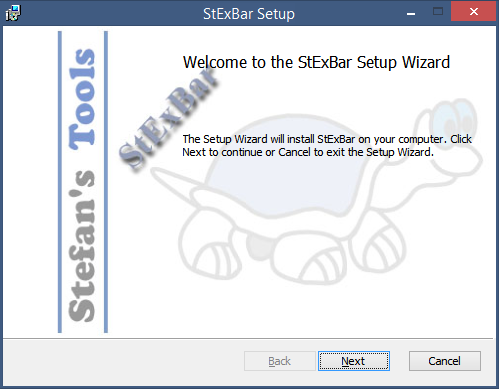
- The toolbar may be automatically enabled but if it does not show, then open Internet Options from Control Panel and go to the Programs tab. Click Manage Add-ons to bring up IE's Addon Manager. You must enable StExbar here.
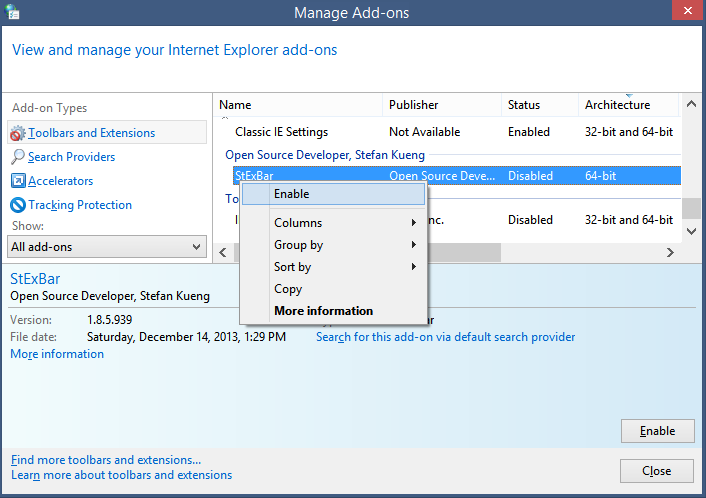
- Now open Windows Explorer and StExBar will show. If it still does not show then follow the instructions below:
- On Windows 7 or on Windows 8/8.1 with the Ribbon Disabled, press F10 to show the menu bar. Now right click on the menu bar and enable StExBar. Or you can also click the View menu -> Toolbars -> Enable StExBar.
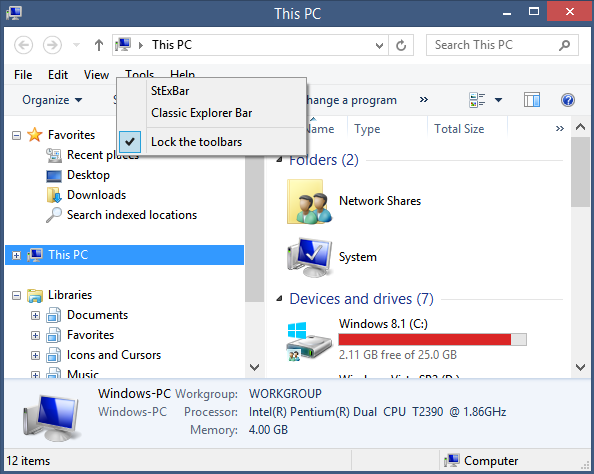
- If you are running Windows 8 or Windows 8.1 with the Ribbon enabled, then go to the View tab of the Ribbon. Click the little dropdown arrow below the Options button and enable StExBar.
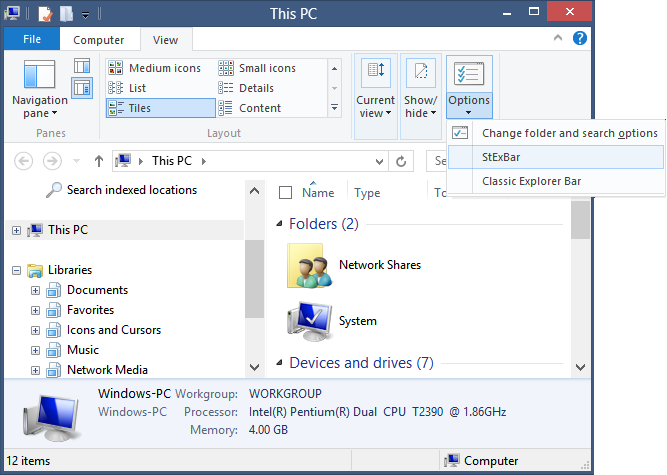
- On Windows 7 or on Windows 8/8.1 with the Ribbon Disabled, press F10 to show the menu bar. Now right click on the menu bar and enable StExBar. Or you can also click the View menu -> Toolbars -> Enable StExBar.
- This is how the toolbar looks when it is enabled:
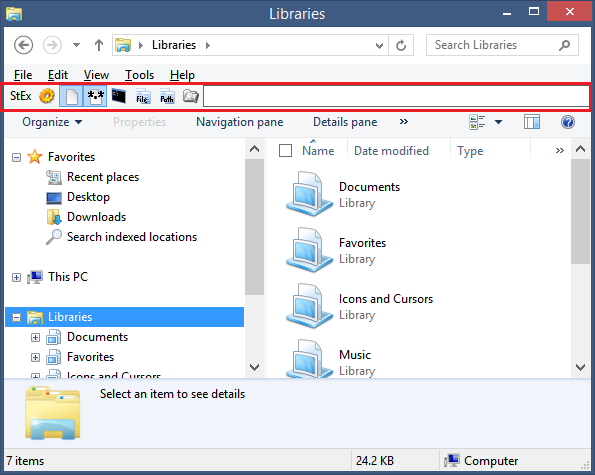
- Clicking the first button with the yellow gear icon brings up its configuration dialog:
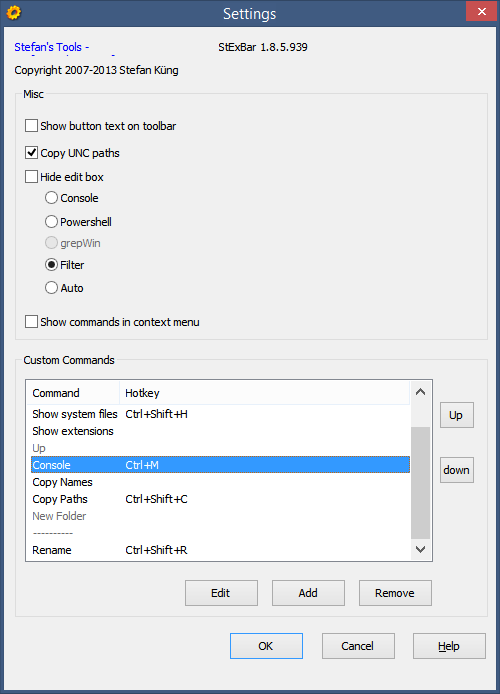
- Here, you can enable "Show button text on toolbar" to show the names of the commands next to their icons. You can also enable the same set of commands that you use on the toolbar inside the directory background context menu which you get when you right an empty area of a folder.
- StExBar's killer feature is its edit box. The edit box is configurable. You can make it work as a command prompt (console), as a PowerShell console, as a grepWin box (which is another tool by the developer of StExBar), or as a simple but powerful filter. If you set it to Auto, the first character entered in the Edit box determines its function (c for console, f for filter, P for PowerShell and so on). Personally, I find the Filter the most useful so that's what I set it to.

- The bottom section of StExBar's settings dialog lets you configure exactly which buttons show on the toolbar. You can add or remove built-in commands, assign custom hotkeys to them or add your own custom command. For built-in commands, you can't edit anything except the hotkey, or you can disable them completely. In the screenshot below, I added the hotkey combination: Ctrl+Shift+. (period) for the Show extensions command.
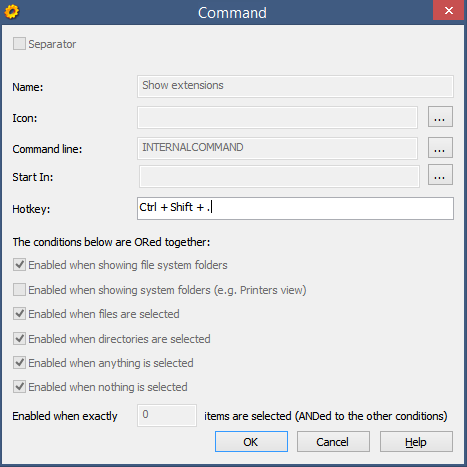
- The built-in commands of StExBar are extremely useful: Show system files (Ctrl+Shift+H), Show extensions, Up button, Console (Ctrl+M), Copy Names, Copy Paths (Ctrl+Shift C), New Folder and Advanced Renamer (Ctrl+Shift+R). On modern versions of Windows, you may not find the Up button and New folder useful so they are disabled by default. The Copy Paths and Copy names functionality is especially handy because unlike context menu extensions with similar functionality, they don't clutter up the context menu and work for UNC (network) paths as well. If no files are selected, the current path is copied. If you select files, the selected file paths/names are copied, complete with double quotes.
- StExBar has more useful hidden keyboard shortcuts which may not be obvious. Ctrl+Win+M opens an elevated command prompt at the path you are browsing in Explorer, as does clicking on the Console button while holding down the Win key.
- The Filter accessed by Ctrl+K lets you instantly filter the contents of folders. You can also type parts of file or folder names to filter them. The filter also takes into account file extensions so you can, for example, type .exe to filter and show only EXE files in a folder. StExBar's filter is not recursive so it's much faster. Unlike Windows Explorer's integrated search box, it does not perform a search, nor does it look inside subfolders, so you will get instant results.
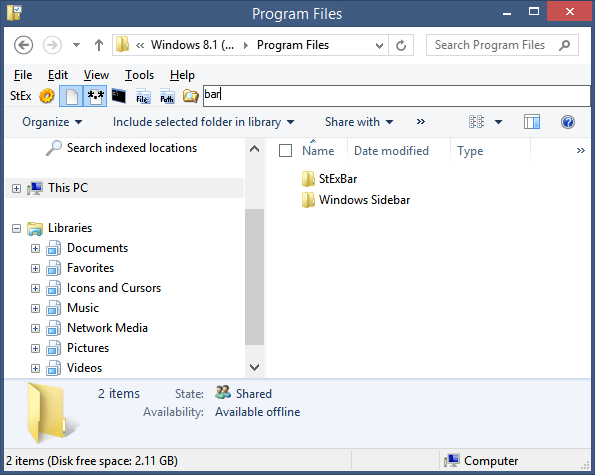
- The Advanced Renamer uses regular expressions. If you are not familiar with them, press the Rename button and then press Help.
- StExBar's custom commands functionality lets you define your own name for the button, its icon, command line, working path and hotkey. You can set the conditions when the button gets enabled and when it gets disabled. You can also use special placeholders in the command line as the Help explains:
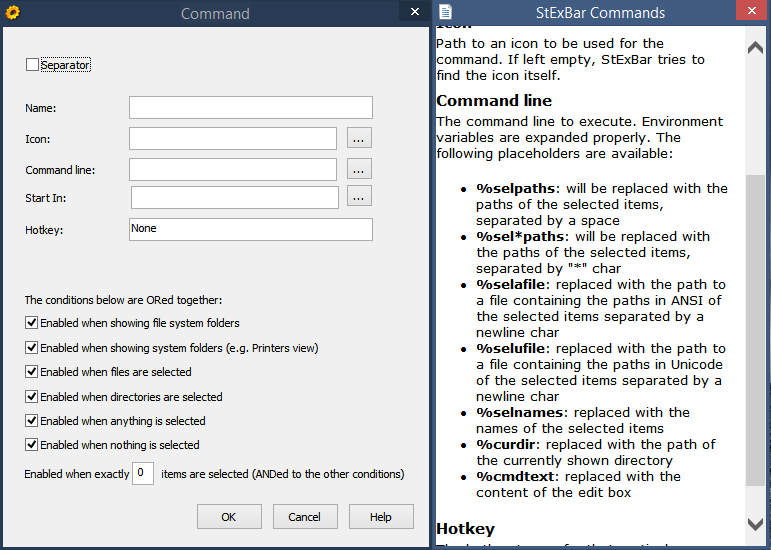
The developer has some example commands on StExBar's description page along with a repository of custom script commands.
Closing words
StExBar is a must-have toolbar for power users of Windows Explorer. It adds essential features. Some of these features have also been added to the Windows 8 Ribbon but you can save space by using them from a more compact toolbar.
Support us
Winaero greatly relies on your support. You can help the site keep bringing you interesting and useful content and software by using these options:
